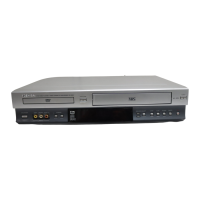Why does TIMER indicator appear after Toshiba SD-V290-S-TU is turned off?
- JJennifer BurtonSep 12, 2025
The TIMER indicator appearing after your Toshiba DVD VCR Combo is turned off is normal. It indicates that the unit is in Timer Recording mode.

Why does TIMER indicator appear after Toshiba SD-V290-S-TU is turned off?
The TIMER indicator appearing after your Toshiba DVD VCR Combo is turned off is normal. It indicates that the unit is in Timer Recording mode.
How to prevent moisture condensation in Toshiba SD-V290-S-TU?
To help prevent moisture condensation in your Toshiba DVD VCR Combo, keep it plugged into an AC power outlet with the power on. If condensation has occurred, wait a few hours for the unit to dry before using it.
| Type | DVD VCR Combo |
|---|---|
| Brand | Toshiba |
| Model | SD-V290-S-TU |
| Video Format | NTSC |
| Recording Formats | VHS |
| Audio Output | Stereo |
| DVD Type | DVD player |
| Progressive Scan | Yes |
| Remote Control | Yes |
| Output Resolution | 480i |
| Playback Formats | DVD, VHS |
| Connections | Composite Video, S-Video |
| VCR Type | VCR |
| Playable File Formats | DVD-Video, CD-DA, CD-R/RW, VCD |
| DVD Formats | DVD-Video |
| VHS Formats | VHS |
Warnings about electric shock, fire risk, rain, and moisture exposure.
FCC regulations and copyright information for the device.
Comprehensive safety guidelines for using the unit, including handling, ventilation, and power.
Precautions for disc handling, connections, sound volume, and laser beam exposure.
Details compatible discs (DVD, VCD, CD) and notes on their playback.
Instructions for remote control battery installation and operation range.
Explanation of front panel buttons like PLAY, STOP, REC, and indicators.
Explains the meaning of various symbols and status messages on the display.
Guide to buttons for controlling playback, menus, and disc/tape functions.
Details on buttons for setup, search, repeat, and other advanced functions.
Describes various output jacks for connecting to TVs and audio systems.
Details antenna input, line inputs, and digital audio output connections.
Guide to connecting the unit to TV signal sources.
Instructions for connecting audio and video signals from external devices.
Steps for connecting via RF coaxial cable and setting TV channel.
How to connect audio and video signals for TV viewing.
Connecting via S-Video for improved picture quality.
Using component cables for high-quality video output.
Explains the information displayed during VCR operation and how to view it.
How to access and adjust VCR menu and display settings.
Configuring language, audio mode, broadcast type, and audio output settings.
Setting up channels via auto programming and manual adjustments.
Procedures for setting the unit's internal clock.
Overview of DVD playback features and on-screen icons.
Understanding DVD playback status and on-screen display options.
Configuring basic preferences like language, picture aspect, and menu language.
Adjusting TV aspect ratio and selecting disc language options.
Setting options for digital audio output like Dolby Digital and PCM.
Explains DRC, Vocal, PBC, Pluge, and DNR for audio enhancement.
Setting playback restrictions based on disc rating and region codes.
Procedures for changing or recovering the parental control password.
How to play tapes, adjust tracking, and use special effects.
Techniques for fast searching, frame-by-frame viewing, and skipping segments.
Locating specific recorded segments using the VISS index.
Steps for recording TV programs, pausing, and restarting recording.
Programming the unit to record multiple programs automatically.
Selecting recording speed (SP/SLP) and repeat modes (Once, Weekly, Daily).
How to view, modify, or delete programmed timer recordings.
Using OTR for quick, preset-length recordings without timer setup.
Copying content from camcorders or other VCRs.
Instructions for transferring content from DVDs to VHS tapes.
Achieving stereo sound from Hi-Fi recorded tapes.
Utilizing MTS for stereo, SAP, and bilingual audio broadcasts.
Using the tape counter, memory features, and tape remaining display.
Information on S-VHS playback, auto play, head cleaning, and blank search.
Basic playback operations, menu navigation, and disc handling.
Moving through titles, chapters, tracks, and using slow motion.
Using pause, frame-by-frame, search modes, and time search functions.
Adjusting sound settings like NORM, 3D SUR, and DIALOGUE.
Using repeat modes, zoom, and marking playback points.
Accessing and using DVD menus, title menus, and disc menus.
Changing audio language, channels, camera angles, and subtitles.
Playing tracks, pausing, moving between tracks, and stopping playback.
Using search, random, repeat, sound enhancement, and changing audio channels.
Steps to play MP3 files, pause, move between tracks, and repeat.
Important information regarding MP3 file formats and disc compatibility.
How to select, view, and navigate JPEG image files.
Repeating file playback and requirements for file naming conventions.
Steps to play WMA files, pause, move between tracks, and repeat.
Compatibility limitations for WMA files, including sampling frequency and bit rate.
Storing favorite tracks or files for various disc types.
Exiting program edit mode and resuming normal playback.
Managing repeat modes and erasing tracks/files from the program list.
Using instant replay and understanding the screen saver function.
Adjusting video modes for optimal picture quality based on disc content.
Solutions for issues like no power, no picture, or no sound.
Resolving problems with disc playback, remote control, and tape issues.
Addressing skipped channels, weak signals, and audio playback problems.
Guidance on preventing and dealing with moisture condensation.
Codes for setting disc audio, subtitle, and menu languages.
Codes for setting the DVD's area code for playback restrictions.
Technical details on power, dimensions, inputs, and outputs.
Specific technical details for the VCR and DVD components.
Details on warranty periods, exclusions, and customer responsibilities.
Procedures for contacting service stations and returning the product for repair.
